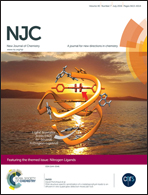Thioester-appended organosilatranes: synthetic investigations and application in the modification of magnetic silica surfaces†
Abstract
The present investigation discloses a series of new organosilicon derivatives (3a–k) tailored with substituted benzoic acid modules (1a–k) via thioesterification with 3-mercaptopropylsilatrane (MPS). Product formation was authenticated using elemental analyses and different spectroscopic methods comprising FT-IR, NMR [1H, 13C] and LC-MS (Q-TOF). Thereafter, complete structural elucidation of compounds 3c and 3f was achieved by the single crystal X-ray technique. Photo-electronic inspection of all compounds by UV-Vis spectroscopy revealed their sensitivity towards substitution patterns. In addition, this is the first time that the potential of a silatranyl moiety has been tested for the modification of a silica surface pre-decorated with a magnetite core. The synthesis was achieved through a facile methodology involving chemical bonding at each stage, which proceeded without any external surfactant or template. The course of the reaction was followed by FT-IR, UV-Vis, XRD, TEM, FESEM, EDX and TGA techniques. Furthermore, the hybrid nanomaterial possessed significant sensorial ability toward copper ions, which makes the present protocol favourable for the construction of a new class of chelating ligands with an in-built multifunctional nanodevice.



 Please wait while we load your content...
Please wait while we load your content...